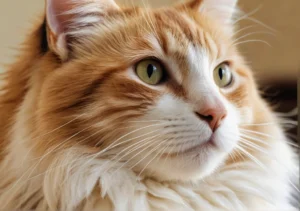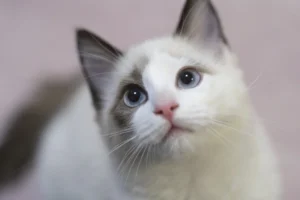Cats are fascinating creatures, with their playful antics and independent personalities. However, one not-so-pleasant aspect of caring for a cat is dealing with dingleberries. If you’ve ever wondered why cats get dingleberries, you’re not alone. Let’s explore this topic further to understand why this happens and how to prevent it.
Have you ever noticed your cat struggling to groom themselves properly? This could be one reason why dingleberries occur in cats.
What causes dingleberries in cats?
Dingleberries in cats are unpleasant but common occurrences that can stem from a few different factors. One of the primary causes is long hair, especially in long-haired breeds like Persians or Maine Coons. The fur around the hind end can easily trap fecal matter, leading to dingleberries. Poor grooming habits can exacerbate this issue, as cats may not be able to adequately clean themselves.
Another key contributor to dingleberries is dehydration. When a cat doesn’t drink enough water, their stools can become dry and hard, making it more difficult to pass without leaving remnants behind. Obesity can also play a role, as overweight cats may struggle to reach their hind end effectively for cleaning.
Furthermore, diet plays a significant role in dingleberry formation. A diet lacking in fiber can result in loose stools that cling to the fur, while diets high in fat can lead to greasy stools that are more likely to stick. Additionally, food allergies or sensitivities could cause digestive issues that contribute to dingleberries.
To help prevent dingleberries, ensure your cat’s fur around the hind end is kept trimmed if necessary, and encourage regular grooming. Providing plenty of fresh water and a balanced diet high in fiber can also help reduce the likelihood of dingleberries forming.
How can improper diet lead to dingleberries?
The connection between a cat’s diet and the presence of dingleberries is crucial to understand. Highly processed diets lacking in essential nutrients can result in poor stool quality, making it more likely for fecal matter to stick to the fur. Low-quality proteins and fillers in cat food can also lead to digestive issues that contribute to dingleberries.
Variety in a cat’s diet is essential to ensure they are getting all the necessary nutrients. Cats are obligate carnivores, meaning their bodies require meat to thrive. A diet rich in high-quality proteins from sources like chicken or fish can aid in proper digestion and reduce the likelihood of dingleberries.
Adding fiber-rich foods to your cat’s diet, such as pumpkin or vegetables, can help regulate their digestive system and promote healthy bowel movements. Probiotics can also be beneficial in maintaining gut health and preventing issues like dingleberries.
In addition to diet, ensuring your cat stays hydrated is key in preventing dingleberries. Encourage water consumption and consider incorporating wet food into their diet for added moisture.
By providing a balanced and nutritious diet, monitoring your cat’s hydration levels, and promoting good grooming habits, you can help minimize the occurrence of dingleberries and keep your feline friend comfortable and clean.
Is grooming behavior a factor in dingleberry formation?
When it comes to those pesky dingleberries on your cat, grooming behavior plays a crucial role. Cats are known for their meticulous grooming habits, but sometimes, they may miss certain areas, leading to the formation of dingleberries. These clingy bits of fur or feces can accumulate around the cat’s hind end, especially in long-haired breeds or overweight cats.
To prevent dingleberries, regular grooming is key. If your furry friend struggles with grooming due to age, weight, or health issues, you can lend a helping hand by gently wiping their hind area with pet wipes or a damp cloth. Trimming the fur around the hindquarters can also help reduce the likelihood of dingleberries forming.
Remember, a clean kitty is a happy kitty, so keep an eye on their grooming habits to avoid dingleberry dilemmas!
And if you want to delve deeper into feline grooming and hygiene, check out the American Association of Feline Practitioners’ guide on feline grooming tips.
Can health issues increase the likelihood of dingleberries?
Did you know that certain health issues can contribute to the development of dingleberries in cats? Underlying health problems such as obesity, diarrhea, constipation, or anal gland issues can all increase the likelihood of dingleberries forming.
If your cat is experiencing frequent dingleberries, it’s essential to address any potential health concerns with your veterinarian. They can help identify and treat any underlying issues that may be contributing to this uncomfortable problem for your feline friend.
By addressing health issues promptly, you can help reduce the occurrence of dingleberries and ensure your cat’s overall well-being and comfort. Don’t hesitate to seek professional advice to keep your furry companion healthy and happy!
What are the potential risks of ignoring dingleberries in cats?
Leaving dingleberries untreated in your furry friend can lead to a hairy situation. These pesky little things can cause discomfort, irritation, and even infections. When dingleberries accumulate, they can become a breeding ground for bacteria, potentially causing skin infections or anal gland issues. Ignoring these butt nuggets is not only unpleasant for your cat but can also result in more serious health issues down the line. So, don’t turn a blind eye to those clingy bits – take action to prevent any unwanted complications.
How can you prevent dingleberries in cats?
Nobody wants a cat sporting dingleberries like a strange accessory. To keep your feline friend clean and comfortable, you can take a few simple steps. Firstly, ensure your cat’s diet is high in fiber to promote healthy digestion and prevent loose stools that can lead to dingleberries. Groom your cat regularly to check for any potential clinging debris and trim the fur around their hind area to reduce the chances of dingleberries forming. Additionally, consider providing your cat with plenty of water to stay hydrated and aid in smooth bowel movements. By taking these preventive measures, you can help your cat stay dingleberry-free and happy.
Tips to prevent dingleberries:
- Fiber-rich diet: Ensure your cat’s food is packed with fiber to maintain good digestion.
- Regular grooming: Keep an eye on your cat’s hind area and trim fur as needed to prevent dingleberries.
- Hydration: Make sure your cat drinks plenty of water to help with digestion and prevent dry stools.
- Veterinary check-up: Schedule regular visits to the vet to address any underlying health issues that could lead to dingleberries.
Remember, a little prevention goes a long way in keeping your cat clean, comfortable, and dingleberry-free.
Are there grooming techniques that can help minimize dingleberries?
When it comes to dealing with pesky dingleberries in your feline friend, grooming plays a crucial role in minimizing their occurrence. Regular brushing can help prevent mats and tangles in your cat’s fur, reducing the likelihood of dingleberries forming. Trim the hair around your cat’s hind end to keep it shorter and cleaner. Wiping your cat’s bottom with pet-safe wipes or a damp cloth can help remove any residue that might lead to dingleberries. Additionally, ensuring your cat’s diet is rich in fiber can promote healthy digestion and reduce the chances of dingleberries forming. Finally, consider adding L-lysine supplements to your cat’s diet as they can help maintain a healthy coat and prevent matting.
What are some alternative solutions for managing dingleberries in cats?
Managing dingleberries in cats can be a challenge, but there are alternative solutions that can help keep your furry friend comfortable. Regular grooming is essential in preventing dingleberries, so make sure to brush your cat’s fur frequently to avoid matting. If your cat is prone to dingleberries, consider using a pet-safe hair detangler to minimize tangles and mats. Another alternative solution is to incorporate probiotics into your cat’s diet to promote healthy digestion. You can also try using cat-safe hygiene wipes to clean your cat’s hind end and prevent dingleberries from forming. And lastly, consider consulting with your veterinarian for personalized advice on managing and preventing dingleberries in your cat.
(Unique Insight: Some cats may have mobility issues or health conditions that make grooming challenging. In such cases, using a pet-friendly grooming glove that fits over your hand can help gently remove debris from your cat’s fur without causing discomfort.)
Alex, a passionate animal lover, has experience in training and understanding animal behavior. As a proud pet parent to two dogs and three cats, he founded AnimalReport.net to share insights from animal experts and expand his knowledge of the animal kingdom.




